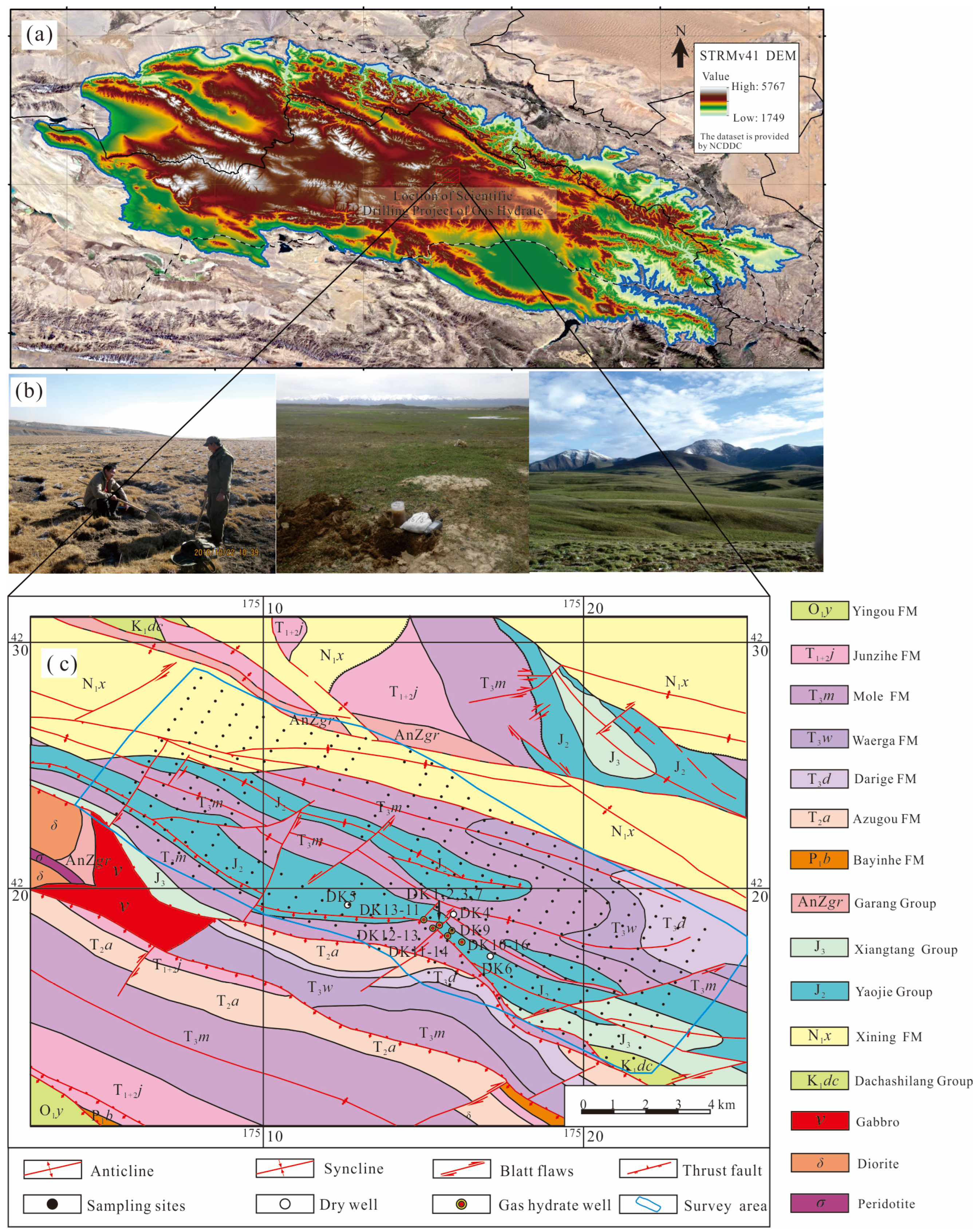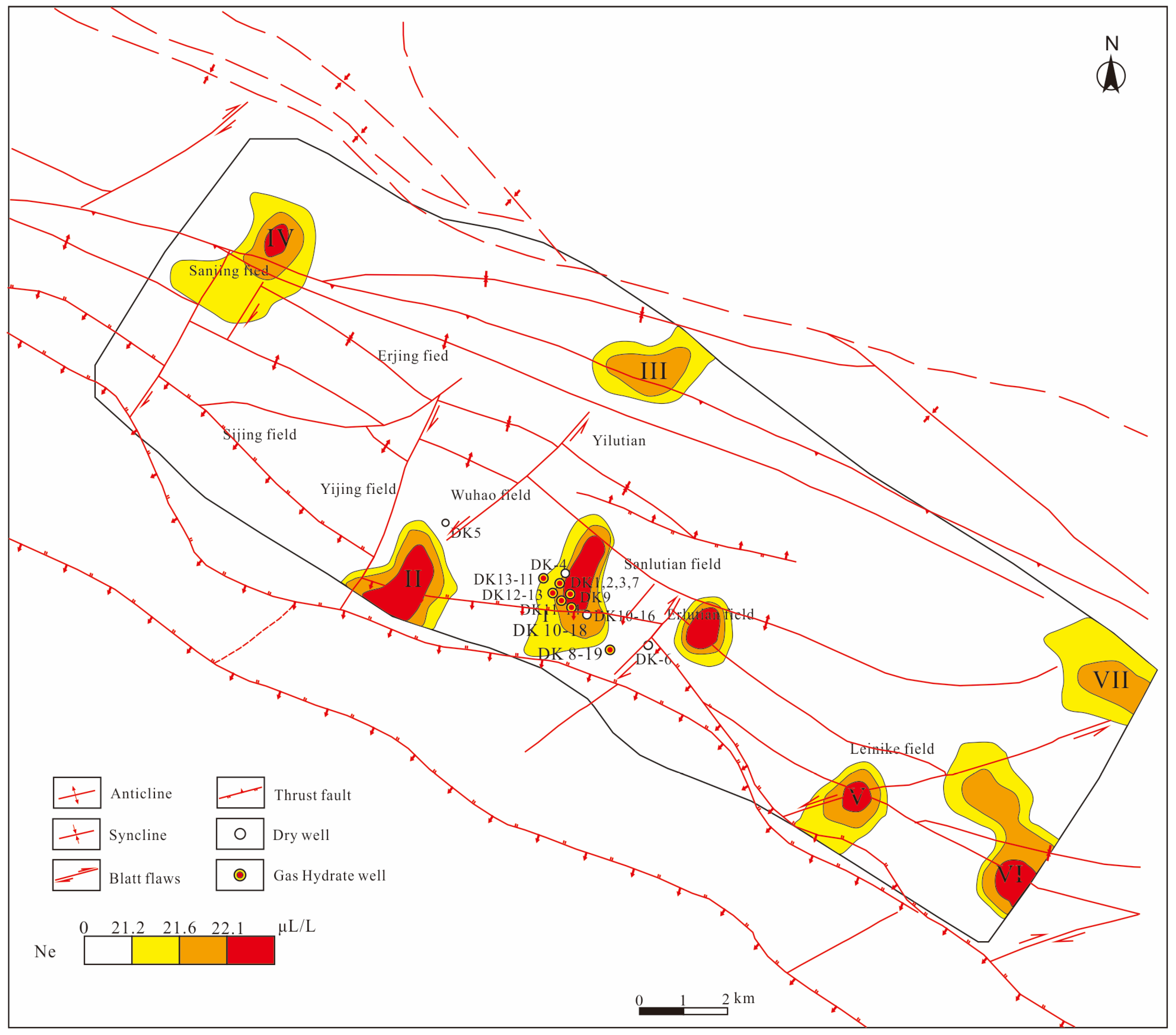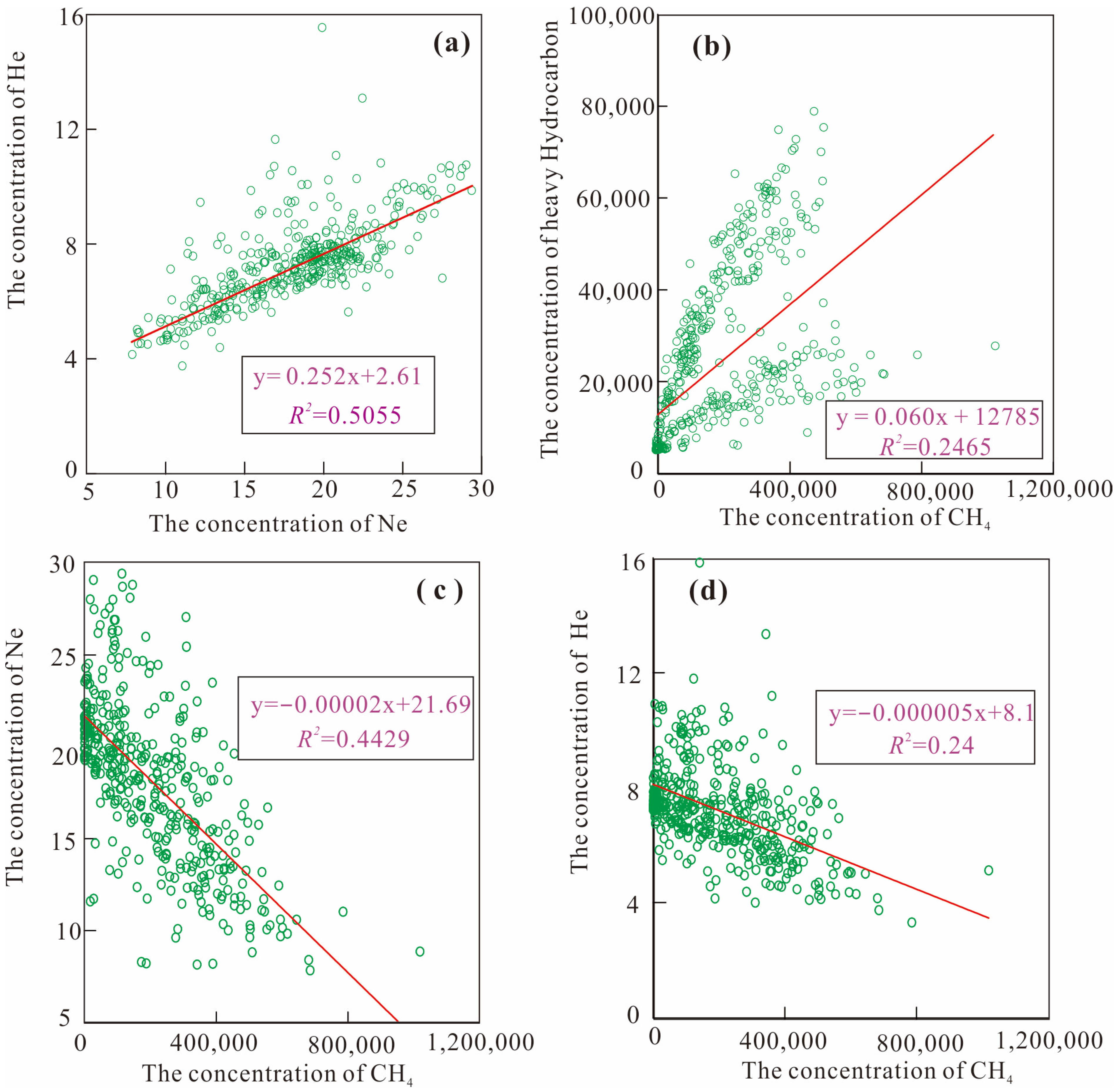Inert Gas—A New Geochemical Technology for Natural Gas Hydrate Exploration in Midlatitude Permafrost
Abstract
:1. Introduction
2. Geological Setting
3. Materials and Methods
3.1. Sampling
3.2. Instrumental Analysis
3.3. Data Analysis
4. Results
4.1. Concentrations of Helium and Neon
4.2. Distribution Characteristics of Helium and Neon
4.2.1. Distribution Characteristics of Helium
4.2.2. Distribution Characteristics of Neon
4.3. Fractal Characteristics of He and Ne
5. Discussion
5.1. Vertical Distribution of Inert Gases in DK-8
5.2. Correlation between Inert Gases and Methane in the Drill Holes
5.3. Geogas Migration Mechanism of Inert Gases
6. Conclusions
- There are eleven gas hydrate wells in the Qilian Mountains: DK-1, DK-2, DK-3, DK-7, DK-8, DK-9, DK-12, DK13-11, DK12-13, DK11-14, and DK8-19. Ten of the eleven wells are located within the anomaly of helium and neon; only DK8-19 is situated outside the anomalous area. Experiments show that inert gases have the potential to be an effective supplementary tool for hydrate exploration in mid-latitude areas.
- The anomalies of He and Ne are affected by neither the microorganisms in the surface marsh nor the coalbed methane. Their near-surface anomalies are in good agreement with the gas hydrates. Headspace gas technology provides a simple and convenient means of field sampling. The utilization of the same headspace gas bottle enables the concurrent analysis of light hydrocarbons and inert gas composition. This capability makes the headspace gas technology a simple technique worth popularizing in the gas hydrate exploration of permafrost areas.
- Geogas migration refers to the microleakage of inert gases in hydrate deposits. The main factors that control the geogas migration of inert gases primarily include the size of the hydrate deposits, the geothermal gradient, and the activity of the inert gases.
Author Contributions
Funding
Data Availability Statement
Acknowledgments
Conflicts of Interest
References
- Sloan, E.D. Fundamental principles and applications of natural gas hydrates. Nature 2003, 426, 353–363. [Google Scholar] [CrossRef] [PubMed]
- Kvenvolden, K.A. Gas hydrates-geological perspective and global change. Rev. Geophys. 1993, 31, 173–187. [Google Scholar] [CrossRef]
- Kvenvolden, K.A.; Lorenson, T.D. The global occurrence of natural gas hydrate. Am. Geophys. Union 2001, 124, 3–18. [Google Scholar]
- Collett, T.S. Permafrost–associated gas hydrate accumulations. Ann. N. Y. Acad. Sci. 1994, 715, 247–269. [Google Scholar] [CrossRef]
- Collett, T.S.; Lee, M.W.; Agena, W.F.; Miller, J.J.; Lewis, K.A.; Zyrianova, M.V.; Boswell, R.; Inks, T.L. Permafrost–associated natural gas hydrate occurrences on the Alaska North Slope. Mar. Pet. Geol. 2011, 28, 279–294. [Google Scholar] [CrossRef]
- Lee, S.Y.; Holder, G.D. Methane hydrates potential as a future energy source. Fuel Process. Technol. 2001, 71, 181–186. [Google Scholar] [CrossRef]
- Zhu, Y.H.; Zhang, Y.Q.; Wen, H.J.; Lu, Z.Q.; Jia, Z.Y.; Li, Y.H.; Li, Q.H.; Liu, C.L.; Wang, P.K.; Guo, X.W. Gas hydrates in the Qilian Mountain permafrost, Qinghai, Northwest China. Acta Geol. Sin. (Engl. Ed.) 2010, 84, 1–10. [Google Scholar] [CrossRef]
- Collett, T.S. Energy resource potential of natural gas hydrates. AAPG Bull. 2002, 86, 1971–1992. [Google Scholar]
- Makogon, Y.F.; Holditch, S.A.; Makogon, T.Y. Natural gas-hydrates—A potential energy source for the 21st Century. J. Pet. Sci. Eng. 2007, 56, 14–31. [Google Scholar] [CrossRef]
- Boswell, R. Is gas hydrate energy within reach? Science 2009, 325, 957–958. [Google Scholar] [CrossRef]
- Collett, T.S.; Boswell, R.; Waite, B.W.; Kumar, P.; Roy, S.K.; Chopra, K. India national gas hydrate program expedition 02 summary of scientific results: Gas hydrate systems along the eastern continental margin of India. Mar. Pet. Geol. 2019, 108, 39–142. [Google Scholar] [CrossRef]
- Kvenvolden, K.A. Methane hydrate in the global organic carbon cycle. Terra Nova. 2002, 14, 302–306. [Google Scholar] [CrossRef]
- Archer, D.; Buffett, B.; Brovkin, V. Ocean methane hydrates as a slow tipping point in the global carbon cycle. Proc. Natl. Acad. Sci. USA 2009, 106, 20596–20601. [Google Scholar] [CrossRef]
- Burton, Z.M.F.; Kroeger, K.F.; Hosford Scheirer, A.; Seol, Y.; Burgreen-Chan, B.; Graham, S. Tectonic uplift destabilizes subsea gas hydrate: A model example from Hikurangi margin, New Zealand. Geophys. Res. Lett. 2020, 47, e2020GL087150. [Google Scholar] [CrossRef]
- Burton, Z.M.F.; Dafov, L.N. Testing the sediment organic contents required for biogenic gas hydrate formation: Insights from synthetic 3-D basin and hydrocarbon system modelling. Fuels 2022, 3, 555–562. [Google Scholar] [CrossRef]
- Burton, Z.M.F.; Dafov, L.N. Salt Diapir-Driven Recycling of Gas Hydrate. Geochem. Geophys. Geosystems 2023, 24, e2022GC010704. [Google Scholar] [CrossRef]
- Farahani, M.V.; Hassanpouryouzband, A.; Yang, J.H.; Tohidi, B. Insights into the climate-driven evolution of gas hydrate-bearing permafrost sediments: Implications for prediction of environmental impacts and security of energy in cold regions. RSC Adv. 2021, 11, 14334–14346. [Google Scholar] [CrossRef] [PubMed]
- Kvenvolden, K.A. Methane hydrate—A major reservoir of carbon in the shallow geosphere? Chem. Geol. 1988, 71, 41–51. [Google Scholar] [CrossRef]
- Collett, T.S.; Dallimore, S.R. Permafrost-Associated Gas Hydrate//Natural Gas Hydrate; Springer: Dordrecht, The Netherlands, 2000; pp. 43–60. [Google Scholar]
- Wang, P.K.; Zhu, Y.H.; Lu, Z.Q.; Bai, M.G.; Huang, X.; Pang, S.J.; Liu, H.; Xiao, R. Research progress of gas hydrates in the Qilian Mountain permafrost, Qinghai, northwest China: Review. Sci. Sin. Phys. Mech. Astron. 2019, 49, 034606. [Google Scholar] [CrossRef]
- Dallimore, S.R.; Collett, T.S. Scientific Results from the Mallik 2002 Gas Hydrate Production Research Well Program, Mackenzie Delta, Northwest Territories, Canada; Geological Survey of Canada: Vancouver, BC, Canada, 2005.
- Makogon, Y.F.; Omelchenko, R.Y. Commercial gas production from Messoyakha deposit in hydrate conditions. J. Nat. Gas Sci. Eng. 2013, 11, 1–6. [Google Scholar] [CrossRef]
- Richard, B.; Dai, J.C.; Shelander, D.; Boswell, R.; Collett, T.; Cook, A.; Dallimore, S.; Fujii, K.; Imasato, Y.; Fukuhara, M.; et al. Developments in Gas Hydrates. Oilfield Rev. 2010, 22, 18–33. [Google Scholar]
- Lee, M.W.; Collett, T.S. In-situ gas hydrate saturation estimated from various well logs at the Mount Elbert Gas Hydrate Stratigraphic Test Well, Alaska North Slope. Mar. Pet. Geol. 2011, 28, 439–449. [Google Scholar] [CrossRef]
- Liang, J.Q.; Zhang, W.; Lu, J.A.; Wei, J.G.; Kuang, Z.G.; He, Y.L. Geological occurrence and accumulation mechanism of natural gas hydrates in the eastern Qiongdongnan Basin of the South China Sea: Insights from site GMGS5-W9-2018. Mar. Geol. 2019, 418, 106042. [Google Scholar] [CrossRef]
- Ye, J.L.; Qin, X.W.; Xie, W.W.; Lu, H.L.; Ma, B.J.; Qiu, H.J.; Liang, J.Q.; Lu, J.A.; Kuang, Z.G.; Lu, C.; et al. Main progress of the second gas hydrate trial production in the South China Sea. China Geol. 2020, 47, 557–568. [Google Scholar]
- Li, J.F.; Ye, J.L.; Qin, X.W.; Qiu, H.J.; Wu, N.Y.; Lu, H.L.; Xie, W.W.; Lu, J.G.; Peng, F.; Xu, Z.Q.; et al. The first offshore natural gas hydrate production test in South China Sea. China Geol. 2018, 1, 5–16. [Google Scholar] [CrossRef]
- Lu, Z.Q.; Zhu, Y.H.; Zhang, Y.Q.; Wen, H.J.; Li, Y.H.; Liu, C.L. Gas hydrate occurrences in the Qilian Mountain permafrost, Qinghai Province, China. Cold Reg. Sci. Technol. 2011, 66, 93–104. [Google Scholar] [CrossRef]
- Lin, Z.Z.; Pan, H.P.; Fang, H.; Gao, W.L.; Liu, D.M. High-altitude well log evaluation of a permafrost gas hydrate reservoir in the Muli area of Qinghai, China. Sci. Rep. 2018, 8, 12596. [Google Scholar] [CrossRef] [PubMed]
- Fang, S.; Lin, Z.; Zhang, Z.; Zhang, C.; Du, T. Gas hydrate saturation estimates in the Muli permafrost area considering bayesian discriminant functions. J. Pet. Sci. Eng. 2020, 195, 107872. [Google Scholar] [CrossRef]
- Collett, T.S.; Johnson, A.H.; Knapp, C.C.; Bosewell, R. Natural gas hydrates: A review. Am. Assoc. Pet. Geol. Mem. 2009, 89, 146–219. [Google Scholar]
- Boswell, R.; Moridis, G.; Reagan, M.; Reagan, M.; Collett, T.S. Gas hydrate accumulation types and their application to numerical simulation. In Proceedings of the Seventh International Conference on Gas Hydrate, Edinburgh, UK, 17–21 July 2011. [Google Scholar]
- Fang, H.; Xu, M.C.; Lin, Z.Z.; Zhong, Q.; Bai, D.W.; Liu, J.X.; Pei, F.G.; He, M.X. Geophysical characteristics of gas hydrate in the Muli area, Qinghai province. J. Nat. Gas Sci. Eng. 2017, 37, 539–550. [Google Scholar] [CrossRef]
- Ning, F.L.; Liang, J.Q.; Wu, N.Y.; Zhu, Y.H.; Wu, S.G.; Liu, C.L.; Wei, C.F.; Wang, D.D.; Zhang, Z.; Xu, M.; et al. Reservoir characteristics of natural gas hydrates in China. Nat. Gas Ind. 2020, 8, 1–24. [Google Scholar]
- Lu, Z.Q.; Tang, S.Q.; Luo, X.L.; Zhai, G.Y.; Fan, D.W.; Wang, T.; Zhu, Y.H.; Xiao, R. A natural gas hydrate-oil-gas system in the Qilian Mountain permafrost area, northeast of Qinghai-Tibet Plateau. China Geol. 2020, 3, 511–523. [Google Scholar] [CrossRef]
- Zhang, F.G.; Qin, A.H.; Zhu, Y.H.; Sun, Z.J.; Zhang, S.Y.; Wang, H.Y.; Yang, Z.B.; Zhou, Y.L. A discussion on geochemical migration mechanism of natural gas hydrate in Qilian Mountain permafrost. Miner. Depos. 2020, 39, 326–336. [Google Scholar]
- Hunt, M.J. Petroleum Geochemistry and Geology (A Series of Books in Geology); W.H. Freeman: New York, NY, USA, 1979. [Google Scholar]
- Tissot, B.P.; Welte, D.H. Petroleum Formation and Occurrence; Springer: Berlin/Heidelberg, Germany, 1984. [Google Scholar]
- Burton, Z.F.M.; Moldowan, J.M.; Sykes, R.; Graham, S.A. Unraveling petroleum degradation, maturity, and mixing and addressing impact on petroleum prospectivity: Insights from frontier exploration regions in New Zealand. Energy Fuels 2018, 32, 1287–1296. [Google Scholar] [CrossRef]
- Burton, Z.F.M.; Moldowan, J.M.; Magoon, L.B.; Sykes, R.; Graham, S. Interpretation of source rock depositional environment and age from seep oil, east coast of New Zealand. Int. J. Earth Sci. 2019, 108, 1079–1091. [Google Scholar] [CrossRef]
- Sun, Z.J.; Yang, Z.B.; Mei, H.; Qin, A.H.; Zhang, F.G.; Zhou, Y.L.; Zhang, S.Y.; Mei, B.W. Geochemical characteristics of the shallow soil above the Muli gas hydrate reservoir in the permafrost region of the Qilian Mountains, China. J. Geochem. Explor. 2014, 139, 160–169. [Google Scholar] [CrossRef]
- Craig, H.; Lupton, J.E.; Primordial, N. Helium and hydrogen in oceanic basalts. Earth Planet. Sci. Lett. 1976, 31, 369–389. [Google Scholar] [CrossRef]
- Craig, H.; Lupton, J.E. Helium isotope variations. Trans. Am. Geophys. Union 1978, 59, 1194. [Google Scholar]
- Ciotoli, G.; Lombardi, S.; Morandi, S.; Zarlenga, F. A multidisciplinary, statistical approach to study the relationships between helium leakage and neotectonic activity in a gas province: The Vasto basin, Abruzzo-Molise (central Italy). Am. Assoc. Pet. Geol. 2004, 88, 355–372. [Google Scholar] [CrossRef]
- Roberts, A.A. Helium manometry in exploring for hydrocarbons: Part II. In Unconventional Methods in Exploration for Petroleum and Natural Gas II; Southern Methodist University Press: Dallas, TX, USA, 1981. [Google Scholar]
- Elliot, T.; Ballentine, C.J.; O’Nions, R.K.; Ricciuto, T. Carbon, helium, neon and argon isotopes in a Po basin natural gas field. Chem. Geol. 1993, 106, 429–440. [Google Scholar] [CrossRef]
- Pinti, D.L.; Marty, B. Noble gases in crude oils from the Paris Basin, France: Implication of the origin of fluids and constraints on oil-water-gas interactions. Geochim. Et Cosmochim. Acta 1995, 59, 3389–3404. [Google Scholar] [CrossRef]
- Ginsburg, G.D.; Soloviev, V.A.; Cranston, R.E.; Lorensen, T.D.; Kvenvolden, K.A. Gas hydrates from the continental slope, offshore Sakhalin Island, Okhotsk Sea. Geo-Mar. Lett. 1993, 13, 41–48. [Google Scholar] [CrossRef]
- Prasolov, E.M.; Tokarev, I.V.; Ginsburg, G.D. Helium and other noble gases in gas-hydrate sediments of the Hakon Mosby Mud Volcano. Geo-Mar. Lett. 1999, 19, 84–88. [Google Scholar] [CrossRef]
- Zhang, F.G.; Yang, Z.B.; Zhou, Y.L.; Zhang, S.; Yu, L.S. Accumulation mechanism of natural gas hydrate in the Qilian Mountain permafrost, Qinghai, China. Front. Energy Res. 2022, 10, 1006421. [Google Scholar] [CrossRef]
- Wen, H.J.; Shao, L.Y.; Li, Y.H.; Lu, J.; Zhang, S.L. Structure and stratigraphy of the Juhugeng coal district at Muli, Tianjun County, Qinghai Province. Geol. Bull. China 2011, 30, 1823–1828. [Google Scholar]
- Fu, J.H.; Zhou, L.F. Triassic stratigraphic provinces of the southern Qilian basin and their petro-geological features. Northwest Geosci. 2000, 21, 64–72. [Google Scholar]
- Niu, Z.X.; Geng, Q.M.; Dou, L. Palaeogeographic analysis of Muli coalfield Juhugeng coalmine area in Qinghai Province. Geol. Rev. 2015, 61, 158–159. [Google Scholar]
- Lu, Z.Q.; Zhu, Y.H.; Zhang, Y. Basic geological characteristics of gas hydrates in Qilian Mountain permafrost area, Qinghai Province. Miner. Depos. 2010, 29, 182–191. [Google Scholar]
- Wang, P.K.; Huang, X.; Pang, S.J.; Zhu, Y.H.; Lu, Z.Q.; Zhang, S.; Liu, H.; Yang, K.L.; Li, B. Geochemical dynamics of the gas hydrate system in the Qilian Mountain Permafrost, Qinghai, Northwest China. Mar. PetGeol. 2015, 59, 72–90. [Google Scholar] [CrossRef]
- Li, B.; Sun, Y.H.; Guo, W.; Shan, X.L.; Wang, P.K.; Pang, S.J.; Jia, R.; Zhang, G.B. The mechanism and verification analysis of permafrost-associated gas hydrate formation in the Qilian Mountain, Northwest China. Mar. PetGeol. 2017, 86, 787–797. [Google Scholar] [CrossRef]
- Huang, X.; Zhu, Y.H.; Wang, P.K.; Guo, X.W. Hydrocarbon gas composition and origin of core gas from the gas hydrate reservoir in Qilian Mountain permafros. Geol. Bull. China. 2011, 30, 1851–1856. [Google Scholar]
- Wang, P.K.; Zhu, Y.H.; Lu, Z.Q.; Huang, X.; Pang, S.J.; Zhang, S. Gas hydrate stability zone migration occurred in the Qilian mountain permafrost, Qinghai, Northwest China: Evidences from pyrite morphology and pyrite sulfur isotope. Cold Reg. Sci. Technol. 2014, 98, 8–17. [Google Scholar] [CrossRef]
- Li, G.Z.; Hu, B. The latest progress of the analytical techniques of the petroleumgeochemical exploration in China: Problems and development direction. Nat. Gas Geosci. 2013, 24, 1171–1185. [Google Scholar]
- Deans, D.R. An improved technique for back-flushing gas chromatographic columns. J. Chromatogr. A 1965, 18, 477–481. [Google Scholar] [CrossRef] [PubMed]
- Li, Z.Y.; Zhou, J.L.; Zhao, J.H. Determination of He, Ne, H2 in tank top gas by chromatographic method and its application in Helium resource survey. Northwestern Geol. 2022, 55, 267–273. [Google Scholar]
- Ozima, M.; Podosek, F.A. Noble Gas Geochemistry; Cambridge Univ Press: London, UK, 1983. [Google Scholar]
- Mamyrin, B.A.; Tolstikhin, I.N. Helium Isotopes in Nauture; Elsevier: Amsterdam, The Netherlands, 1984; pp. 1–173. [Google Scholar]
- Holland, P.W.; Emerson, D.E. A determination of the helium 4 content of near-surface atmospheric air within the continental United States. J. Geophys. Res. 1987, 92, 12557–12566. [Google Scholar] [CrossRef]
- Lu, Z.Q.; Zhu, Y.H.; Liu, H.; Zhang, Y.Q.; Jin, C.S.; Huang, X.; Wang, P.K. Gas source for gas hydrate and its significance in the Qilian Mountain permafrost, Qinghai. Mar. Pet. Geol. 2013, 43, 341–348. [Google Scholar] [CrossRef]
- Sun, Z.J.; Yang, Z.B.; Lu, Z.Q.; Zhang, F.G.; Zhang, S.Y.; Zhou, Y.L.; Wang, H.Y. Geochemical Characteristics of Trace Elements in Soil above Sanlutian Natural Gas Hydrates in the Qilian Mountains. Geoscience 2015, 29, 1164–1172. [Google Scholar]
- Sloan, E.D.; Koh, C.A. Clathrate Hydrate of Natural Gases, 3rd ed.; Taylor and Francis Group: New York, NY, USA, 2008; pp. 554–555. [Google Scholar]
- Duddridge, G.A.; Grainger, P.; Durrance, E.M. Fault detection using soil gas geochemistry. Quat. J. Eng. Geol. 1991, 24, 427–435. [Google Scholar] [CrossRef]
- Klusman, R.W. Soil Gas and Related Methods for Natural Resource Exploration; John Wiley & Sons Ltd.: Chichester, UK, 1993; p. 483. [Google Scholar]
- Ciotoli, G.; Etiope, G.; Guerra, M.; Lombardi, S. The detection of concealed faults in the Ofanto basin using the correlation between soil-gas fracture surveys. Tectonophysics 1999, 301, 321–332. [Google Scholar]
- Zhang, F.G.; Tang, R.L.; Zhou, Y.L.; Zhang, S.Y.; Sun, Z.J.; Wang, H.Y. A new tool for natural gas hydrate exploration in permafrost regions: Analysis of inert gas helium neon. Acta Geol. Sin. 2019, 93, 751–761. [Google Scholar]
- Zhou, Y.L.; Sun, Z.J.; Yang, Z.B. Geochemical characteristics and implications of helium and neon in natural gas hydrates deposits in the Muli permafrost, Qilian Mountains. Geoscience 2018, 32, 995–1002. [Google Scholar]





| Element | Minimum | Maximum | Mean | Standard Deviation | Comments |
|---|---|---|---|---|---|
| He/μL·L−1 | 5.030 | 5.756 | 5.402 | 0.130 | Atmosphere [62] |
| He/μL·L−1 | / | / | 5.240 | / | Atmosphere [63] |
| He/μL·L−1 | / | / | 5.222 ± 0.017 | / | Atmosphere [64] |
| Ne/μL·L−1 | / | / | 18.18 | / | Atmosphere [64] |
| Ne/μL·L−1 | / | / | 18.2 | / | Atmosphere [63] |
| He/μL·L−1 | 5.92 | 10.36 | 7.99 | / | In this investigation |
| Ne/μL·L−1 | 13.53 | 28.05 | 20.8 | / |
| Area | Depth/m | He/Ne | He/μL·L−1 | Ne/μL·L−1 |
|---|---|---|---|---|
| Atmosphere [64] | 0.288 | 5.222 ± 0.017 | 18.18 | |
| Hydrate in Sanlutian | Surrounding rocks above the hydrate layer | 0.40 | 9.70 | 24.4 |
| 150–155 m of the hydrate layer | 0.37 | 7.45 | 20.4 | |
| Surrounding rocks above the hydrate layer | 0.37 | 9.07 | 24.7 | |
| 227–236 m of the hydrate layer | 0.36 | 8.12 | 22.5 |
Disclaimer/Publisher’s Note: The statements, opinions and data contained in all publications are solely those of the individual author(s) and contributor(s) and not of MDPI and/or the editor(s). MDPI and/or the editor(s) disclaim responsibility for any injury to people or property resulting from any ideas, methods, instructions or products referred to in the content. |
© 2023 by the authors. Licensee MDPI, Basel, Switzerland. This article is an open access article distributed under the terms and conditions of the Creative Commons Attribution (CC BY) license (https://creativecommons.org/licenses/by/4.0/).
Share and Cite
Tang, R.; Xu, J.; Chen, Z.; Liu, B.; Bai, J. Inert Gas—A New Geochemical Technology for Natural Gas Hydrate Exploration in Midlatitude Permafrost. Minerals 2023, 13, 1393. https://doi.org/10.3390/min13111393
Tang R, Xu J, Chen Z, Liu B, Bai J. Inert Gas—A New Geochemical Technology for Natural Gas Hydrate Exploration in Midlatitude Permafrost. Minerals. 2023; 13(11):1393. https://doi.org/10.3390/min13111393
Chicago/Turabian StyleTang, Ruiling, Jinli Xu, Ziwan Chen, Bin Liu, and Jinfeng Bai. 2023. "Inert Gas—A New Geochemical Technology for Natural Gas Hydrate Exploration in Midlatitude Permafrost" Minerals 13, no. 11: 1393. https://doi.org/10.3390/min13111393
APA StyleTang, R., Xu, J., Chen, Z., Liu, B., & Bai, J. (2023). Inert Gas—A New Geochemical Technology for Natural Gas Hydrate Exploration in Midlatitude Permafrost. Minerals, 13(11), 1393. https://doi.org/10.3390/min13111393





